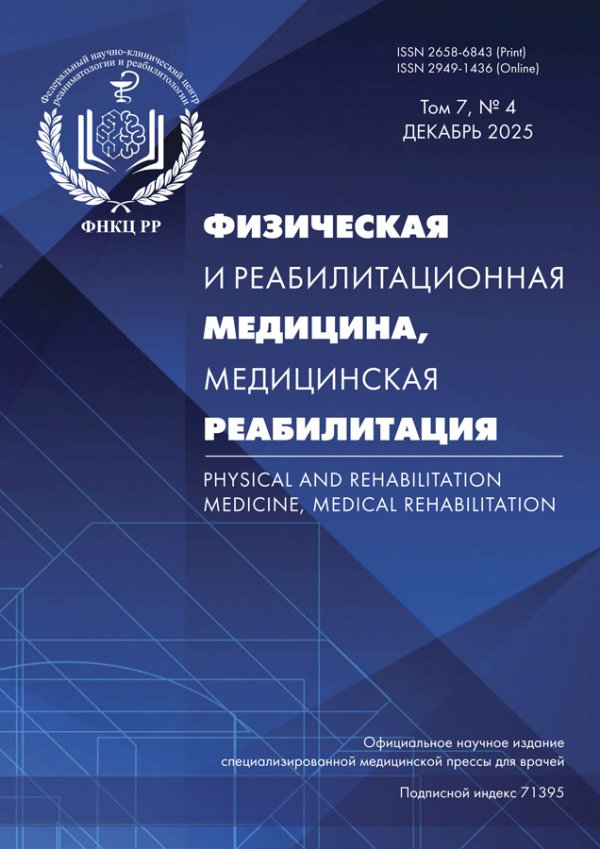Pathophysiological substantiation of the complex approach to rehabilitation of patients with myofascial pain syndrome of the neck region
- Authors: Shimarova O.V.1, Malakhovskiy V.V.1, Zilov V.G.1
-
Affiliations:
- Federal State Autonomous Educational Institution of Higher Education “I.M. Sechenov First Moscow State Medical University” of the Ministry of Education of Russia (Sechenov University)
- Issue: Vol 2, No 1 (2020)
- Pages: 66-70
- Section: REVIEWS
- URL: https://journals.rcsi.science/2658-6843/article/view/20422
- DOI: https://doi.org/10.36425/rehab20422
- ID: 20422
Cite item
Full Text
Abstract
Myofascial pain syndromes are a widespread pathology, which is a condition that is characterized by local muscle stiffness and the formation of trigger points in them. The pathophysiology of myofascial pain syndromes is not fully understood. Studies indicate the role of dysfunction of the end plate of the muscle, impaired proprioreception and sensomotor control, central sensitization. The review presents a modern view of approaches to the treatment of myofasial pain syndrome of the neck region, based on an understanding of its pathophysiology.
Full Text
##article.viewOnOriginalSite##About the authors
O. V. Shimarova
Federal State Autonomous Educational Institution of Higher Education “I.M. Sechenov First Moscow State Medical University” of the Ministry of Education of Russia (Sechenov University)
Author for correspondence.
Email: olgashimarova@inbox.ru
ORCID iD: 0000-0003-1416-2484
врач ЛФК
Russian Federation, 8-2, Trubetskaya street, Moscow, 119992V. V. Malakhovskiy
Federal State Autonomous Educational Institution of Higher Education “I.M. Sechenov First Moscow State Medical University” of the Ministry of Education of Russia (Sechenov University)
Email: olgashimarova@inbox.ru
ORCID iD: 0000-0002-5024-5239
д.м.н., профессор кафедры интегративной медицины Института профессионального образования
Russian Federation, 8-2, Trubetskaya street, Moscow, 119992V. G. Zilov
Federal State Autonomous Educational Institution of Higher Education “I.M. Sechenov First Moscow State Medical University” of the Ministry of Education of Russia (Sechenov University)
Email: olgashimarova@inbox.ru
ORCID iD: 0000-0003-3908-6801
д.м.н., академик РАН, заведующий кафедрой интегративной медицины
Russian Federation, 8-2, Trubetskaya street, Moscow, 119992References
- Bourgaize S, Newton G, Kumbhare D, Srbely J. A comparison of the clinical manifestation and pathophysiology of myofascial pain syndrome and fibromyalgia: implications for differential diagnosis and management. J Can Chiropr Assoc. 2018;62(1):26−41.
- Dommerholt J, Bron C, Franssen J. Myofascial trigger points: an evidence-informed review. J Manual Manipulativ Ther. 2006;14(4): 203−221. doi: 10.1179/106698106790819991.
- Simons DG, Travell JG. Myofascial pain and dysfunction. The trigger point manual. Vol. 1. Upper half of body. Baltimore: Williams & Wilkins; 1999. Рp. 34−36.
- Широков В.А. Миофасциальный болевой синдром: проблемы диагностики и лечения // Эффективная фармакотерапия. — 2017. — № 21. — С. 22−29. [Shirokov V.A. Myofascial pain syndrome: problems of diagnosis and treatment. Effektivnaya farmakoterapiya. 2017;(21):22−29. (In Russ).]
- Qureshi N, Alsubaie H, Ali G. Myofascial pain syndrome: a concise update on clinical, diagnostic and integrative and alternative therapeutic perspectives. Int Neuropsychiatr Dis J. 2019;13(1):1−14. doi: 10.9734/indj/2019/v13i130100.
- Simons D. Diagnostic criteria of myofascial pain caused by trigger points. J Musculoskeletal Pain. 1999;7(1-2): 111−120. doi: 10.1300/j094v07n01_11.
- Holanda L, Fernandes A, Cabral A, Santos F. Pathophysiology of myofascial trigger points: a review of literature. Int J Basic Appl Sci. 2014;4(1):73−77. doi: 10.14419/ijbas.v4i1.3888.
- Bron C, Dommerholt JD. Etiology of myofascial trigger points. Curr Pain Headache Rep. 2012;16(5):439−444. doi: 10.1007/s11916-012-0289-4.
- Isabel de-la-Llave-Rincón A, Puentedura E, Fernández-de-las- Peñas C. Clinical presentation and manual therapy for upper quadrant musculoskeletal conditions. J Man Manip Ther. 2011; 19(4):201−211. doi: 10.1179/106698111X13129729551985.
- Gattie E, Cleland JA, Snodgrass S. The effectiveness of trigger point dry needling for musculoskeletal conditions by physical therapists: a systematic review and meta-analysis. J Orthop Sports Phys Ther. 2017;47(3):133−149. doi: 10.2519/jospt.2017.7096.
- Latremoliere A. Woolf C. Central sensitization: a generator of pain hypersensitivity by central neural plasticity. J Pain. 2009;10(9):895−926. doi: 10.1016/j.jpain.2009.06.012.
- Shah J, Thaker N, Heimur J, et al. Myofascial trigger points then and now: a historical and scientific perspective. PMR. 2015;7(7):746−761. doi: 10.1016/j.pmrj.2015.01.024.
- Barton P, Hayes K. Neck flexor muscle strength, efficiency, and relaxation times in normal subjects and subjects with unilateral neck pain and headache. Arch Phys Med Rehabil. 1996;77(7):680−687. doi: 10.1016/s0003- 9993(96)90008-8.
- Jordan A, Mehlsen J, Ostergaard K. A comparison of physical characteristics between patients seeking treatment for neck pain and age-matched healthy people. J Manipulative Physiol Ther. 1997;20(7):468−475.
- Yinen J. Physical exercises and functional rehabilitation for the management of chronic neck pain. Eura Medicophys. 2007;43(1):119−132.
- Lederman E. Neuromuscular rehabilitation in manual and physical therapies: principles to practice. Edinburgh: Churchill Livingstone Elsevier; 2010.
- Adler SS, Beckers D. PNF in practice: an illustrated guide. Berlin, Heidelberg, Springer; 1993.
- Stanton T, Leake H, Chalmers K, Moseley G. Evidence of impaired proprioception in chronic idiopathic neck pain: a systematic review and meta-analysis. Physiotherapy. 2016;96(6):876−887. doi: 10.2522/ptj.20150241.
- Иваничев В.Г. О роли проприорецепции в миофасциальном болевом синдроме шеи при дискоординации движений // Казанский медицинский журнал. — 2008. — Т. 89. — № 3. — С. 328−331. [Ivanichev VG. About the role of proprioreception in miofascial pain syndrome of the neck in dyscoordiated motion. Kazanskiy meditsinskiy zhurnal. 2008;89(3):328−331. (In Russ).]
Supplementary files








